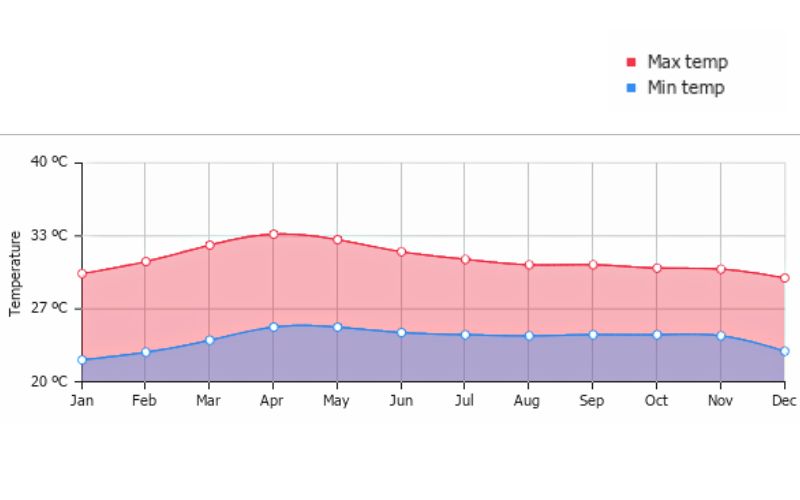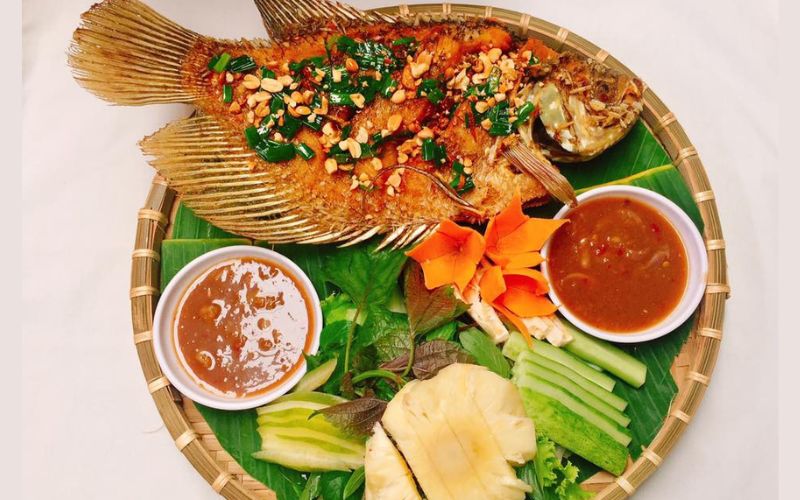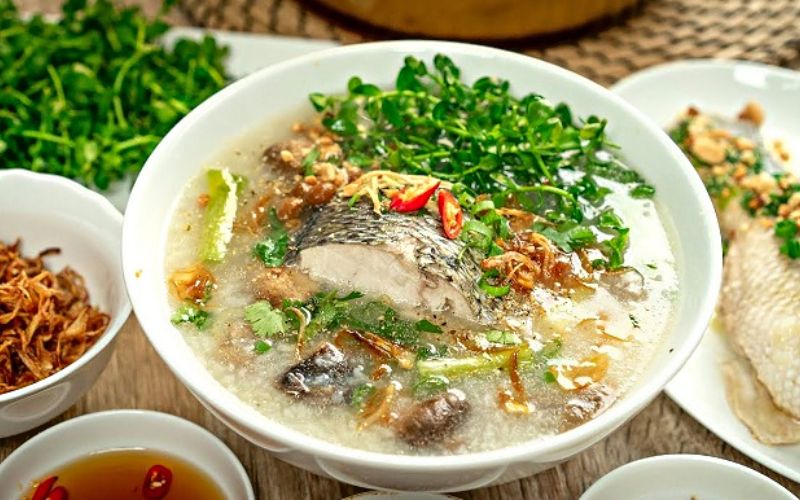Cai Be is a small charming town located 150 kilometers from Saigon – Ho Chi Minh City – and is one of the best options for one-day Mekong River tours.
General Information

Cai Be location – Travel guide by IDC
Colorful fruit and vegetable gardens, traditional crafts, a French church from 1935, and an impressive traditional house decorate the destination. The famous Cai Be floating market is shrinking as smart shops and supermarkets replace it. One of the first impressions of the area is the Catholic cathedral near the floating market.
There are numerous small canals in the Cai Be area that invites a sampan discovery tour. Bicycling on narrow roads alongside small side canals is an excellent way to explore the area. Many of the small shady canals that branch off from the larger river arms are difficult to spot due to lush greenery. On an exploration tour, you may believe you have reached a dead end, but it continues after an overgrown bend.
Cai Be weather & Best time to visit
Cai Be welcomes you at any time of year, and each season will undoubtedly provide you with a unique type of pleasure and satisfaction. The best time, however, is during the floating season, which runs from September to December.

Cai Be weather & Best time to visit
- Season of floatation (September to December): The best time to visit Cai Be and the Mekong Delta region, in general, is now. You can go fishing in our traditional wooden boats, explore untouched nature, and relax in some orchards.
- Season of rain (May to October): It is not a bad idea to visit Cai Be during the rainy season because the rains are brief and will not disrupt your trip.
- Dry season (January – April): It is hot and dry during this time, but it is harvest season here, and you can participate in fruit-picking activities with the locals..
Getting to and around Cai Be
There are numerous modes of transportation available to get to Cai Be depending on your time constraints and interests. There are currently no direct flights to Cai Be. Tan Son Nhat and Can Tho airports are the closest.
Bicycle and motorcycle travel
While you can rent a motorcycle to explore the delta and Cai Be town, most visitors prefer to use the free bicycles provided by most resorts and homestays. The roads are bumpy and muddy at times, but the distances are short. You’ll notice that many locals prefer to travel by bike, so you’ll be in good company. Motorbikes are obviously the best option for those who want to have more experiences while driving through beautiful scenery. However, for families and large groups, a bus or coach is the most secure mode of transportation.
Bus/ Coach
Buses leave from 97B Nguyn Duy Street in Saigon’s District 5. Because the bus stops in Cai Be, you won’t have to worry about where to get off. Simply continue until the last stop to arrive in downtown Cai Be. Take the public bus Futa bus line or Thanh Buoi bus line from Can Tho to Cai Be. These buses are great, new, and air-conditioned, and they run every 15 minutes from Can Tho to HCMC. You simply tell the driver to drop you off in Cai Be town. If you want a private car with an experienced driver, contact us for a car rental.
Boat
The best way to explore Cai Be Floating Market is to take a 2-hour boat trip with a local tour guide. A shared boat ticket costs between 40,000 and 80,000 VND per person, and a boat can carry approximately 10-15 people.
Cruises

Cruises from Can Tho to Cai Be
Daily overnight cruises run from Can Tho to Cai Be and from Cai Be to Can Tho. Cai Be River is the confluence of the Mekong River’s tributaries. This town offers a variety of cruises for visitors interested in exploring nature and the majestic Mekong River. Excursions on the Mekong can last a day, an overnight, or even cross-country between Vietnam, Cambodia, and Laos. With the help of the mighty Mekong River, an increasing number of tourists choose Cai Be as the starting point for the trip of a lifetime – the Mekong Delta expedition.
Ferry travel
Two passenger ferries run between the Cai Be mainland and the Mekong River island of Tan Phong. The first ferry departs from Cai Be near the tourist pier and arrives at the western end of Tan Phong Island. The second ferry departs from further downriver near Hip C and brings you closer to the center of Tan Phong Island. This allows you to ride your bike in a loop. The ferries run every 10 minutes or so, so you won’t have to wait long to cross. You can ride your bike or motorcycle up the ramp to the boat.
You should also bring as little luggage as possible. The following are strongly advised instead:
- Sun-stop coat
- Casual clothes
- Simple shoes or sandals to easily get on and off the boat
- Mosquito and insect repellent
- Sunglasses, hat
- Medicines, travel sickness medicine, and other personal stuff.
Where to Stay in Cai Be
Cai Be has a lot of homestays and hotels. You can select the appropriate types of accommodations based on your budget and expectations. Dong Hoa Hiep Commune, Cai Be, also has some old houses. Ba Duc Old House, Cai Huy Old House, and Ba Kiet Old House are the best preserved. They were built in the traditional style of the area. Some were rebuilt as part of a collaboration program between the Vietnamese government and the Japan International Cooperation Agency.
If you decide to stay at one of the Cai Be homestays on the islet, request that the bus driver drop you off at the Cai Be Tourist Pier. When you arrive at the harbor, the locals from the homestays will arrange to pick you up in a boat.

Mekong Lodge
- Mekong Lodge
Address: Dong Hoa Hiep – US $52
- The Durian Lodge
Address: No 100, Group 4, An Hoa Hamlet, Dong Hoa Hiep – US $40
- Ba Duc Ancient House
Adress: 155 An Loi, Dong Hoa Hiep – US $46
- Mekong Riverside Boutique Resort & Spa
Address: Hoa Qui Ward, Hoa Khanh Subdistrict, Cai Be – US $79
- Mekong – Real Homestay
Address: Hiep Non, Hiep Duc, Cai Lay, Cai Be – US $8
Places to visit in Cai Be
Cai Be Floating Market

Cai Be Floating Market
The floating market here usually starts early in the morning. To capture the most vibrant and bustling scenery, visitors should plan to spend one night in Vinh Long and bring a camera, hat, sunscreen, and insect repellent. At 3-4 a.m., the market is crowded with a wide range of traders and sellers. The busiest time of day is between 5 and 6 a.m., which should be the best time for you to visit Cai Be and immerse yourself in the business life of the locals.
Cai Be Floating Market is a small and relatively unknown floating market in the Mekong Delta. It is held on Tan Phong Island, at the Tien River’s confluence, in the territory of three provinces: Tien Giang, Vinh Long, and Ben Tre. Boats of various sizes carrying hundreds of different commodities are the only mode of transportation here. Unfortunately, the Cai Be floating market is shrinking year by year as trade shifts more and more into modern central markets. The Catholic cathedral in the background of the floating market makes an excellent photo backdrop.
Cai Be Church

Cai Be Church
Visitors will admire Cai Be church’s Roman architecture of the West made of reinforced concrete and cast stone, which has survived the ups and downs of time to retain its elegant and ancient beauty. Roman architecture has had a significant impact on the world in both Asia and other continents as a typical architectural style associated with the history of territories in Western Europe during a period.
We can still see Roman architecture in church buildings built during the French colonial period in our country, such as Notre Dame Cathedral in Saigon, Tan Dinh church, Ba Dinh church, Cai Be church… Cai Be church, in particular, has beautiful architecture, the highest bell tower, and the most beautiful location of any church in the Mekong Delta.
Tan Phong Islet

Fruit garden in Tan Phong Islet
Tan Phong is a Mekong River islet reached via a five-minute ferry ride. The island is a tropical paradise. Narrow channels crisscross the land, forming rich soil for Cai Be farmers to cultivate in order to grow delicious fruits. Plump jackfruits, rambutans, mangoes, and mangosteens dangle from the island’s many trees. Allow yourself an afternoon to explore the islet’s tiny lanes by bicycle.
Ba Duc Old House
This is the Phan family’s home, which is now commonly referred to as Mr. Ba Duc’s home (i.e. Mr. Phan Van Duc – the 6th generation successor of this house). Mr. Phan Van Dang’s house, built in 1850, has an architectural style that blends Southern and French cultures.
Ba Kiet Old House

Ba Kiet Old House
Cai Be has some historic merchant houses located along one of the canals just outside of town. Mr. Kiet’s Historic House was constructed in 1838 and has been owned by wealthy Vietnamese families since then. Guests are welcome to stroll around the main room and admire the beautiful architecture and furnishings. A covered patio is accessible via the back door, where you can dine on the set meal of the day. You’ll dine on a massive deep-fried elephant ear fish.
My Thuan Bridge

My Thuan Bridge
When visiting Vinh Long or other Western provinces, you should put the bridge on your bucket list. Making a photo stop with the unique architectural bridge will not be forgotten as a highlight of the tour.
Tân Phong is a Mekong River islet accessible by ferry in five minutes. The island is a tropical haven. Narrow channels cut through the land, forming rich soil for Cái Bè farmers to cultivate in order to grow delectable fruits. Plump jackfruit, rambutans, mangoes, and mangosteens dangle from the many trees on the island. Allow yourself an afternoon to cycle through the islet’s tiny lanes. Surrounded by lush greenery, ride through tiny bridges and along the water’s edge.
Things to do in Cai Be
Tea drinking
When it’s time for tea, stop by Hai Yen Bee Farm for a tour of their honey farm, followed by a delicious honeyed drink.
Kayaking and Canoeing

Kayaking in Cai Be
There are many small canals and less boat traffic on the islets, making kayaking an enjoyable activity. At low tide, the muddy fresh water might be interesting. It’s a good afternoon activity. Make sure you’re wearing a life jacket.
Cycling
This is a popular activity in Cai Be, Mekong Delta. Bicycling in Vietnam’s small towns is actually enjoyable. When you start your journey, make sure to mark the location of your hotel or homestay on your map because these roads have a lot of twists and turns that could confuse you.
Boat traveling on Cai Be Floating Market
You’ll have unique opportunities to see and photograph all kinds of riverside commerce – from a boat ride on the busy river to a cruise through the mysterious canals, to learn about merchant life in the South West and sample the delicious fresh fruit grown locally. Moreover, the postcard-like natural scenery of poetic azure and pure fresh water will surely amaze you at first sight, and then interesting moments of relaxation will emerge when you float along the river on the boat. The floating market usually closes at 8 pm, when business starts to shut down.
If you dislike a crowded and noisy environment, the time after 4 p.m. is ideal for you. With less sunlight and a cooler temperature than in the morning, you can enjoy the peaceful moments of watching the charming sunset from your boat, the numerous lights from the “floating street,” and fluttering with the sweet beautiful Aulacese opera, all of which are wonderful experiences.
What to Eat in Cai Be
Cai Be is well-known for its many delicious colorful fruits, including small pip durian from Cai Mon (Ben Tre), Nam Roi pomelo from Binh Minh (Vinh Long), longan, orange, and many different types of unique-tasting mango. There are also many other fruit trees, such as sapote, guava, apple, tangerine, jackfruit, plum, peach, and so on. In comparison to other gardens in the Mekong Delta region, Cai Be gardens are known as “the first rich and abundant garden.” There are fruits in four seasons, giving visitors a wide range of fruit options.

Hoa Loc mango with sticky rice
Hoa Loc mango is one of the most popular mango varieties from the Mekong Delta in Vietnam and is known for its attractive color, delicious flavor, and high nutritional value. These mangoes are mainly grown in the Cai Be district, where they cover more than a thousand hectares and produce around 15,000 tons per year. The Hoa Loc mango weighs an average of 350 to 450 grams, has an oblong shape, golden skin when ripe, bright yellow flesh, and a delicious, aromatic taste.
Coconut Candy

Coconut Candy
With its sweet sweetness, fragrance, and natural oily coconut flavor, Vietnamese coconut candy is one of the most popular candies in Vietnam. It is also a great souvenir for visitors to Vietnam. The specialty is growing in popularity and has become a staple in the gift baskets of visitors to Ben Tre, My Tho Cai Be, and Vinh Long.
Cai Be Rice Cake
A crispy puffed rice snack that comes in a variety of flavors is one of Delta’s specialties. And any visitor passing through the area should not pass up the opportunity to witness the fascinating manufacturing process. Whole grains of rice with their husks intact are poured into a large pot previously filled with Mekong River black sand. The rice mixture puffs and pops as it is stirred over a fire, and it is then filtered twice through a mesh to remove the black sand and remaining husks. The crispy rice is then placed in another wok-shaped pot and mixed with sugar and water syrup.
Elephant Ear Fish (fried giant gourami)

Deep Fried Elephant Ear Fish
Locals usually breed the silver giant fish in garden ditches. The fish is usually sweet, chewy and delicious. The giant fish can be prepared in a variety of ways, including stewed, steamed with soy sauce, and most deliciously fried with rice paper. All visitors will be disappointed if they don’t try the fried giant fish in the Vinh Long River area. The Pan-Seared Giant Fish Dish looks simple but requires extensive preparation, especially the dipping sauce. When it’s time to eat, guests place the vegetables on a thin layer of moist rice paper, then scoop up each piece of hot fish, add herbs, cinnamon, and pure white vermicelli, and wrap it.
Snakehead fish porridge with bitter herb

Snakehead fish porridge with bitter herb
Cai Be specializes in snakehead fish. Snakehead fish porridge with bitter herbs is served here. A bowl of hot porridge topped with snakehead fish meat and fresh herbs will leave you speechless. The combination of bitter herbs and hot porridge is perfect. This is a dish that can be found anywhere from Tien Giang’s daily meals to high-end restaurants.
We hope the information above is helpful for your trip! Don’t hesitate to contact us and plan your own trip right now!
